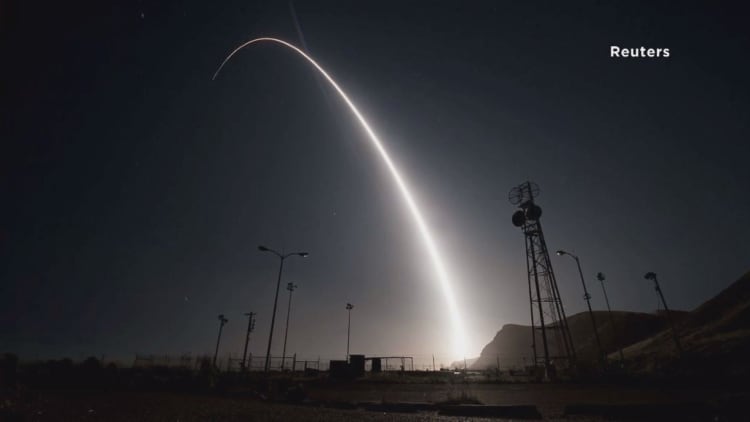
The U.S. is scheduled to conduct a test of an unarmed Minuteman III intercontinental ballistic missile from California on Wednesday, less than a week after North Korea test-fired its own long-range missile.
"The purpose of the ICBM test launch program is to validate and verify the effectiveness, readiness and accuracy of the weapon system," the Air Force Global Strike Command said a statement.
On Friday, North Korea test-launched its Hwasong-14 missile, marking the second time the secretive regime had fired an ICBM. In response to the Friday launch by Pyongyang, President Donald Trump warned Friday "the United States will take all necessary steps to ensure the security of the American homeland and protect our allies in the region."
Air Force Capt. Michele Rollins, a spokesperson for the strike command, told CNBC the U.S. military schedules four test-launches per fiscal year and the actual schedule is created several years in advance so it is unrelated to the recent developments. "Planning for this particular launch started a little over a year ago," she said.

Even so, the Minuteman III test is still seen as a reminder to North Korean leader Kim Jong Un and others of the nuclear options the U.S. military has in its arsenal. Last month, the U.S. also sent two B-1 long-range bombers over the Korean Peninsula in a show of strength and is known to have nuclear submarines in the region.
The Minuteman III missile will be test-launched from Vandenberg Air Force Base about 160 miles northwest of Los Angeles. The missile is expected to land about 4,800 miles away in the Ronald Reagan Ballistic Missile Defense Test Site, which was formerly known as Kwajalein Missile Range, in the Marshall Islands. The U.S. has more than 400 Minuteman III missiles in underground silos at three bases, and the weapons have a range in excess of 8,000 miles.
The Air Force's ground-based Minuteman III, which was first deployed in the 1970s, is one leg of the nation's nuclear triad — land, sea and air-based capabilities. The U.S. military has spent more than $7 billion since 2000 to modernize the aging Minuteman III weapons but it's scheduled to be replaced in a decade with a follow-on system known as Ground-Based Strategic Deterrent (GBSD).
The Arms Control Association, a Washington-based research and advocacy group, notes that an independent Department of Defense estimate indicated that the GBSD could cost "as high as $140 billion," although it comes at a time when superpowers such as Russia and China are modernizing their weapons. Also there are rogue countries such as North Korea that also are a nuclear threat with missile development programs.
"The Minuteman III remains a reliable system," said Reif Kingston, director of disarmament and threat reduction policy for the ACA. "While DOD is moving forward with replacing the existing system, it has yet to make a compelling case as to why the Minuteman III force can't be reduced and the missile life extended beyond 2030."
However, in Senate testimony in February the vice chief of staff of the Air Force, Gen. Stephen Wilson, said GBSD "must proceed as planned in order to ensure the ground leg of the nuclear triad remains credible and effective in the decades ahead."
Boeing was the original prime systems integrator and manufacturer of the Minuteman-series missiles for the Air Force and is a contender for the next-generation GBSD system competition. Northrop Grumman and Lockheed Martin also are contenders.
The president's fiscal 2018 budget request includes just more than $200 million for the GBSD program, above the $114 million budgeted for the current year ending Sept. 30. Most of the money the Pentagon has allocated so far for the ground-based missile replacement program has been in research and development costs rather than outright acquisition.
WATCH: N. Korea fired test missile that may have landed off Japanese coast



